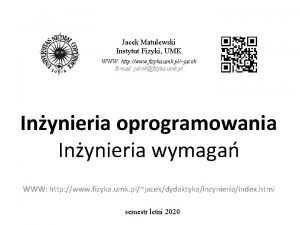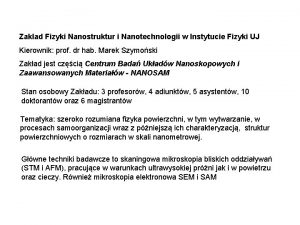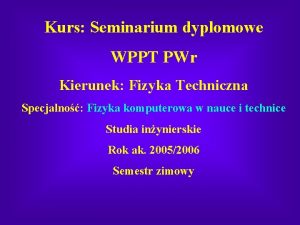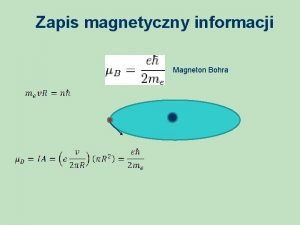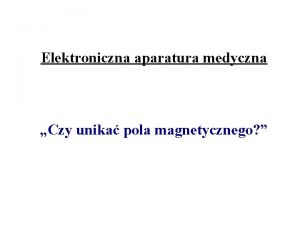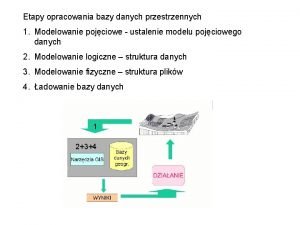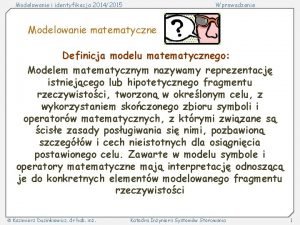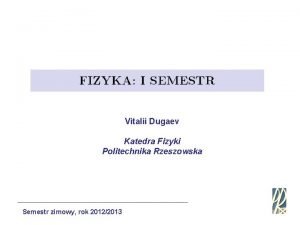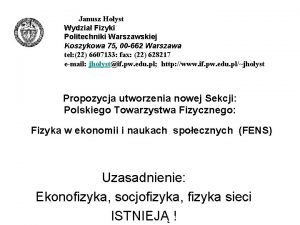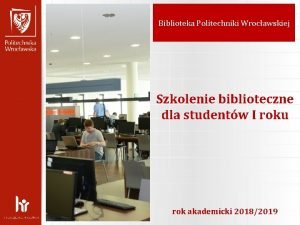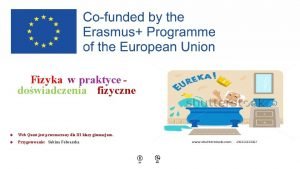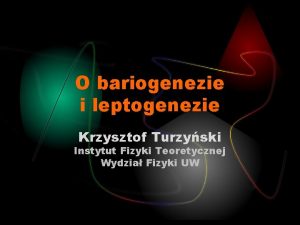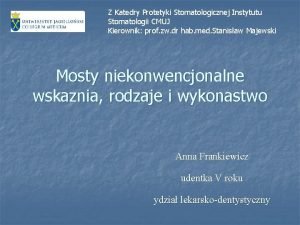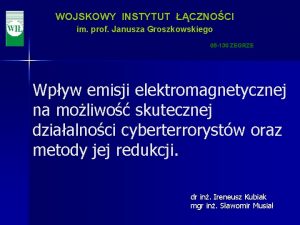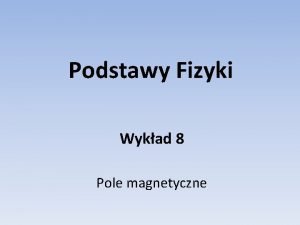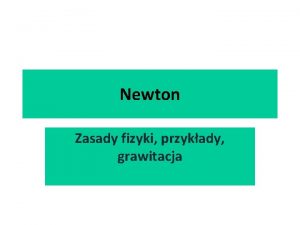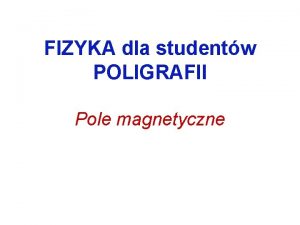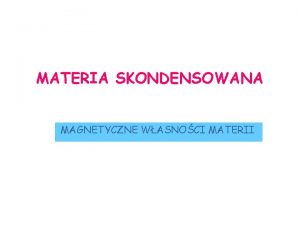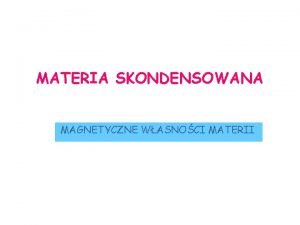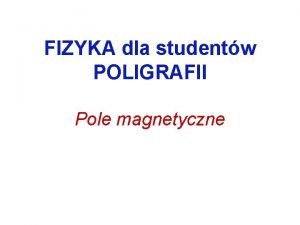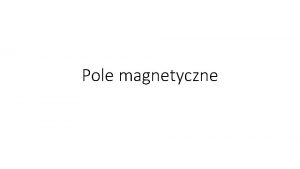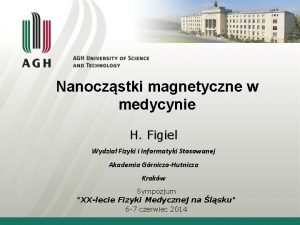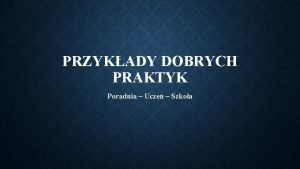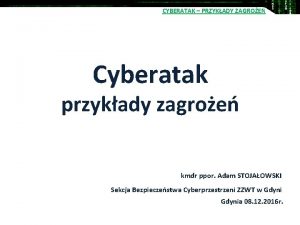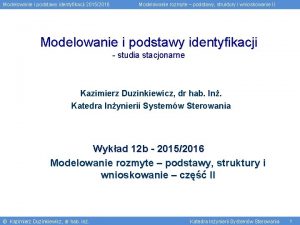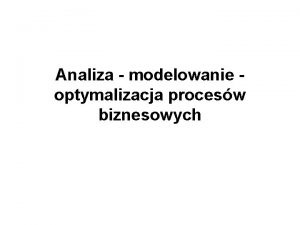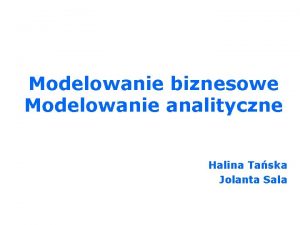Molekuy magnetyczne Przykady zastosowanie modelowanie Seminarium Instytut Fizyki







![[Mn 12 O 12(O 2 CMe)12(H 2 O)4] First proven example: Mn 12 -ac [Mn 12 O 12(O 2 CMe)12(H 2 O)4] First proven example: Mn 12 -ac](https://slidetodoc.com/presentation_image_h/1744c38fe1d3b2d1f2fc8ef1010725db/image-8.jpg)










- Slides: 18

Molekuły magnetyczne Przykłady, zastosowanie, modelowanie Seminarium Instytut Fizyki ZUT, 11. 06. 2010 Wojciech Florek (na podstawie prezentacji D. Tomeckiej) Zakład Fizyki Komputerowej, Wydział Fizyki, UAM Poznań (częściowo po angielsku)

W. Wernsdorfer, Adv. Chem. Phys. 118, 99 -190 (2001); also ar. Xiv/cond-mat/0101104.

Magnetyki molekularne i molekuły magnetyczne (molecules containing magnetically interacting metallic ions) first developed in late 1960 s, 1970 s Why to use magnetic molecules? • Transition few-spin system => many-spin system, contribution to understanding of bulk magnetism; • Transition quantum spin system (s = 1/2) => classical spin system (s. Fe = 5/2, s. Gd = 7/2); • Easy to produce, single crystals with => 1017 identical molecules can be synthesized and practically completely characterized; • Speculative applications: magnetic storage devices, magnets in biological systems, lightinduced nanoswitches, displays, catalysts, qubits for quantum computers. Materials science: • One molecule can be seen as one bit. • This leads to unprecedented data densities. • Conventional materials are reaching the superparamagnetic limit. Physics: • These systems are in between classical and quantum magnetic systems. • They show distinct quantum properties.

Magnesy jednomolekułowe (SMM – Single Molecule Magnets) (np. Fe 8, Mn 12) SMM klasa molekuł magnetycznych, dla których obserwujemy histerezę oraz powolną relaksację namagnesowania na poziomie pojedynczej molekuły: v Stan podstawowy o dużym spinie wypadkowym v Duża anizotropia osiowa (ZFS – Zero-Field Splitting) Differs from a simple paramagnet which would have random spin orientation in the absence of a magnetic field. Differs from a ferromagnet or ferrimagnet as retention of orientation is not related to movement of domain walls. As magnetic domains are not involved, no superparamagnetic limit to size of particle/molecule that could store information A single molecule magnets show their properties after solution or putting in a matrix, like a polymer. Applications of Nanomagnets Magnetic drug delivery Spintronics MRI contrast agents Ferrofluids Quantum effects in mesoscopic matter Hyperthermic treatments Magnetocaloric effect High-density information storage Quantum computation

Natural Nanomagnets: • Ferritin Man on average has 3 -4 g of iron 30 mg per day are exchanged in plasma. Ferritin stores iron in mineral form; Ferritins are found in animals, vegetables, mushrooms and bacteria The internal core, 7 nm, may contain up to 4, 000 iron(III) ions Approximately Fe. O(OH) Magnetism depends on the number of ions Magnetic measurements provide information on the number of ions in the core • Magnetosomes Nanomagnets embedded in cell membranes Magnetotactic bacteria iron core

The first single molecule magnet: Mn 12 -acetate Lis, 1980 Mn(III) S=2 Mn(IV) S = 3/2 Oxygen Carbon [Mn 12 O 12(CH 3 COO)16(H 2 O)4]· 2 CH 3 COOH· 4 H 20 R. Sessoli et al. JACS 115, 1804 (1993) • Ferrimagnetically coupled magnetic ions (Jintra 100 K) • Well defined giant spin (S = 10) at low temperatures (T < 35 K) • Easy-axis anisotropy due to Jahn-Teller distortion on Mn(III) • Crystallizes into a tetragonal structure with S 4 site symmetry • Organic ligands ("chicken fat") isolate the molecules

Mn 12 -acetate Energy levels of the S=10 spin manifold split by an axial anisotropy (top). Overcoming of the barrier can occur through a thermal activation or through a tunnel mechanism involving the ground doublet or thermally excited states. When an axial field is applied the levels on the opposite sides of the barrier are no more in coincidence (b) and tunnelling is suppressed unless specific values of the field are reached (c).
![Mn 12 O 12O 2 CMe12H 2 O4 First proven example Mn 12 ac [Mn 12 O 12(O 2 CMe)12(H 2 O)4] First proven example: Mn 12 -ac](https://slidetodoc.com/presentation_image_h/1744c38fe1d3b2d1f2fc8ef1010725db/image-8.jpg)
[Mn 12 O 12(O 2 CMe)12(H 2 O)4] First proven example: Mn 12 -ac (Lis, Acta Crystalogr. , Sect. B: Srtuct. Crystallogr. Cryst. Chem. 36, 2042 (1980) Christou et al, J. Amer. Chem. Soc. , 1993, 115, 1804) More recent examples: Mn 4, Fe 8, V 4, Fe 10, Mn 10 and Fe 19 cages SMMs retain spin orientation in the absence of a magnetic field – i. e. nanoscale magnetic memories Molecular structure (X-ray diffraction) A cube containing Mn 4+ ions (blue) surrounded by a ring of Mn 3+ ions (pink), held together by oxides (red lines). Magnetic structure (deduced) Spins on Mn 4+ sites (S = 3/2) anti-ferromagnetically coupled to spins on Mn 3+ sites (S = 2). Spin ground state = 8 x 2 – 4 x 3/2 = 10 S = 10 is a high spin ground state for a molecule. Not highest known. Behaviour of spin is unprecedented. Christou et al, J. Amer. Chem. Soc. , 1993, 115, 1804 Hysteresis for {Mn 12} Hysteresis in magnetisation vs. field for powders or crystals i. e. an energy barrier to reorientation of molecular spin Hysteresis loop for crystals is not smooth – shows steps. Barbara et al, Nature, 1996, 383, 145.

W. Wernsdorfer, Adv. Chem. Phys. 118, 99 -190 (2001); also ar. Xiv/cond-mat/0101104.

Other classes of magnetic molecules: Antiferromagnetic rings (e. g. , Cr 8, Fe 10, Ni 12) • Antiferromagnetic n. n. exchange interaction. • Nonmagnetic S=0 ground state. • One Cr 3+ ion can be replaced by a different ion (ground state with S>0). • Interesting for fundamental physics (e. g. Neel vector tunneling). • Ni-substituted Cr 8 : S=1/2, potentially a good candidate qubit. Cr 8 Fe 10 Winpenny

Ni 12 wheel Ferromagnetic exchange leads to an S = 12 ground state. Hysteresis and Tunnelling in {Ni 12} Cyril Cadiou, Manchester and Wolfgang Wernsdorfer, Grenoble Richard Winpenny, Craig Grant, 1999

Grids (e. g. , Mn 3 x 3) • Antiferromagnetic n. n. exchange interaction. • Magnetic S=5/2 ground state. • 2 d topology. • Quantum oscillations of the total molecular spin induced by applied magnetic field.

Single Chain Magnets, SCM, are magnetic polymers and show also a slow relaxation of their magnetization at low temperatures. Single Chain Molecule example A. Caneschi et al. Angew. Chem. 2001 Chain of Mn 12 molecule Gatteschi, 2004

{Mo 72 Fe 30} • Structure: Fe - yellow, Mo - blue, O - red; • Antiferromagnetic interaction mediated by O-Mo-O bridges ( A. M¨uller et al. , Chem. Phys. Chem. 2, 517 (2001)) • Classical ground state of {Mo 72 Fe 30}: three sublattice structure, coplanar spins (M. Axenovich and M. Luban, Phys. Rev. B 63, 100407 (2001)); • Quantum mechanical ground state S = 0 can only be approximated, dimension of Hilbert space (2 s + 1)N ≈ 1023. • Giant magnetic Keplerate molecule; J. Schnack

Other interesting examples Christou 2004 Mn 84 Ni 4 Fe 8 Wiegart, 1984

Representive Attributes of Molecule-Based Magnets • Low density • Mechanical flexibility • Low-temperature processability • High strength • Modulation/tuning of properties by means of organic chemistry • Solubility • Low environmental contamination • Compatibility with polymers for composites • Biocompatibility • High magnetic susceptibilities • High magnetizations • High remanent magnetizations • Low magnetic anisotropy • Transparency • Semiconducting and/or insulating dc electrical onductivity

APPLICATIONS Magnetic molecules are interesting for both fundamental issues and potential applications: Fundamental issues: * Highly tunable model systems for studying quantum phenomena (quantum tunnelling of the magnetisation (QTM), coherence, quantum-classical crossover, etc. ), and to study microscopic magnetic interactions Main potential applications: * High-density information storage with nanomagnets * Magnetocaloric refrigerants (cooling technology based on the magnetocaloric effect) * Quantum computation Schematic three-dimensional image of a molecular "logic gate" of two naphthalocyanine molecules, which are probed by the tip of the lowtemperature scanning tunneling microscope. By inducing a voltage pulse through the tip to the molecule underneath the tip (shown in the back), the two hydrogen atoms in the adjacent molecule (in white at the center of the molecule in front) change position and electrically switch the entire molecule from "on" to "off". This represents a rudimentary logic-gate, an essential component of computer chips and could be the building block for computers built from molecular components. Credit: IBM

Single Molecule Magnets The Future: writing information to individual molecules 1 Nanometer Mn 12 Ac {Dr. S. Hill}
 Instytut fizyki umk
Instytut fizyki umk Zakład fizyki nanostruktur i nanotechnologii uj
Zakład fizyki nanostruktur i nanotechnologii uj śruba maszyna prosta zastosowanie
śruba maszyna prosta zastosowanie Salejda pwr
Salejda pwr Monopol magnetyczny
Monopol magnetyczny Zasada lewej dłoni
Zasada lewej dłoni Bieguny magnetyczne ziemi
Bieguny magnetyczne ziemi Modelowanie pojęciowe
Modelowanie pojęciowe Modelowanie obiektowe
Modelowanie obiektowe Modelowanie matematyczne przykłady
Modelowanie matematyczne przykłady Praw fizyki pan nie zmienisz
Praw fizyki pan nie zmienisz Katedra fizyki prz
Katedra fizyki prz Koszykowa 75 wydział fizyki
Koszykowa 75 wydział fizyki Pwr strefa otwartej nauki
Pwr strefa otwartej nauki Shutter
Shutter Instytut geofizyki uw
Instytut geofizyki uw Protetyka cmuj
Protetyka cmuj Instytut studiów podyplomowych częstochowa
Instytut studiów podyplomowych częstochowa Wojskowy instytut łączności
Wojskowy instytut łączności
